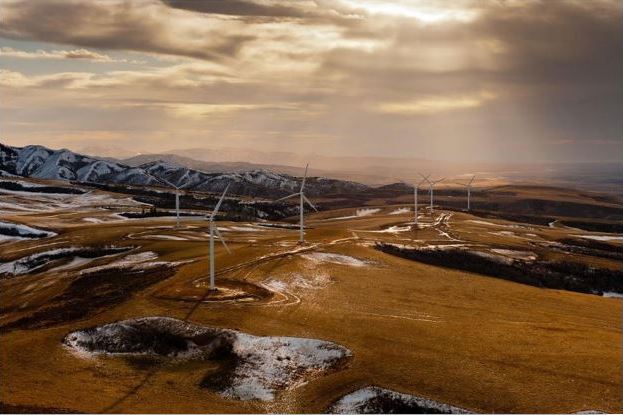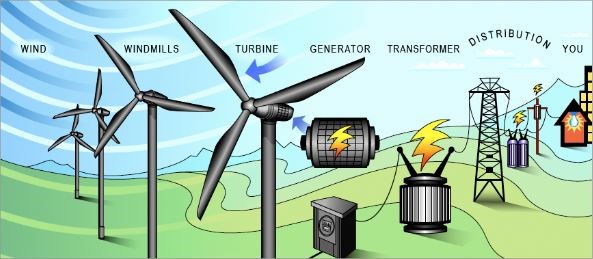
Wind is a clean source of renewable energy. Most wind energy comes from turbines. Wind farms have tens to hundreds of large turbines lined up in windy areas and ridges. Smaller turbines erected on private property can produce enough electricity for a single home.
Idaho’s wind production grew from 207,000 MWh at the end of 2008 to a total of more than 2,657,247 MWh in 2021 (or 1,000 MW).[1] Wind power generated about 16% of Idaho’s net electricity in 2021, provided by nearly 550 wind turbines at utility-scale wind facilities.[2]
Idaho’s most promising wind resources are located in and around the Snake River Plain, particularly on its eastern end.[3] To supplement wind’s intermittent nature, dispatchable resources, including hydroelectric, nuclear power, and natural gas-fired generators, must be ready to meet and/or supplement load requirements when wind generation is not available.
The State of Idaho encourages the development of wind power on state endowment lands.
Idaho has over 2 million acres of endowment land. The Idaho Department of Lands manages this land with the express purpose of creating income for the Idaho State Endowment Fund, which funds schools and other state institutions.
In the 2008 session, the Idaho Legislature passed HCR 054. Its purpose is:
…to direct and encourage the Governor, the Office of Energy, and the Land board to work toward the development of energy production of renewable resources on state endowment lands for the purpose of maximizing the potential returns for education.
More information can be obtained by visiting the Idaho Department of Lands home page.
Most wind energy today comes from wind turbines, either land-based or offshore. The turbines consist of long propeller-like blades attached to a tower that stands on average 100 feet off the ground.[1] When the wind blows, turbines rotate their blades to face into the wind and spin, based on the wind speed. The blades are attached to a rotor that turns generator shafts; this creates electricity, which can be used by the public. Wind turbines can be stand-alone for a single family’s use, or large utility-scale wind farms that can have tens to hundreds of large turbines lined up in windy areas and ridges.

MAPS
- The U.S. Office of Energy Efficiency and Renewable Energy keeps a map of wind potential in the United States. To see what kind of wind energy potential exists near you please, visit: WINDExchange
- To see where Idaho’s wind farms are located, please visit: U.S. Wind Turbine Database
FINANCING
State Energy Loan Program:
- The Idaho Governor’s Office of Energy and Mineral Resources offers low interest energy loans up to $15,000 to Idaho citizens and up to $100,000 to Idaho businesses who are interested in in installing energy efficient products and developing renewable energy projects within the state.
Federal Renewable Production Tax Credit for Land-Based Wind:
- The federal renewable electricity production tax credit (PTC) for land-based wind is a federal tax credit included under Section 45 of the U.S. tax code for electricity generated by wind energy on a per kilowatt-hour (kWh) basis.
- The PTC for land-based wind power projects has been extended an additional year and will remain at 60% of the project’s value, on a per kWh basis, for projects that begin construction by the end of 2021. Previous law had the rate decreasing to 40%. Without any future legislative actions, there will be no wind PTC starting in 2022.
NATIONAL SITES
- American Clean Power Wind Fact Sheet
- Wind Powering America – U.S. Department of Energy
- National Renewable Energy Laboratory (NREL) – National Wind Technology Center
- The NREL Jobs and Economic Development Impacts (JEDI) Wind model allows the user to estimate economic development impacts from wind power projects. JEDI Wind has default information that can be used to run a generic impacts analysis assuming wind industry averages. NREL also provides geospatial wind data.
- American Wind Wildlife Institute (AWWI)
- Northwest Sustainable Energy for Economic Development (NWSEED)
- Renewable Northwest Project
- Utility Variable-Generation Integration Group
- Windustry
WIND PUBLICATIONS
- Small Wind Electric Systems — An Idaho Consumer’s Guide — U.S. Dept. of Energy and the Idaho Department of Water Resources; Energy Division
- Permitting of Small and Medium Sized Wind Turbine Projects in Idaho (PDF)—, A Handbook Guide with Specific Examples for Counties of Bonneville, Cassia, Elmore, Jerome and Twin Falls, Idaho Energy Division, November 2005
- Permitting Small Wind Turbines: A Handbook, Learning from the California Experience (PDF)— American Wind Energy Association (AWEA); Northwest Sustainable Energy for Economic Development (NWSEED)
- Wind Energy for Rural Economic Development — U.S. Dept. of Energy Office of Energy Efficiency and Renewable Energy, June 2004
- Lawrence Berkeley National Lab (US DOE) — A library of renewable energy reports.
- BLM EIS — Final Programmatic Environmental Impact Statement on Wind Energy Development on BLM-Administered Lands in the Western United States, Bureau of Land Management, June 2005
- NWCC publications list — this National Wind Coordinating Committee list includes publications on wildlife/avian considerations, economic development, green power marketing, siting, permitting, policy, transmission, and more.
- Economic Impacts of Proposed Wind Energy Developments in the State of Idaho (PDF)— Idaho Governor’s Office of Resources, Boise, Idaho, August 2004
 Official Government Website
Official Government Website